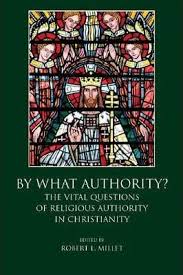Articles/Essays – Volume 44, No. 3
On Vital Questions | Robert L. Millet, ed., By What Authority? The Vital Question of Religious Authority in Christianity
Opening his short contribution to this collection of essays, Roger Olson, professor of theology at Baylor University, writes: “One can hardly do justice to the subject of religious authority in a brief reflection essay” (180). Indeed. And while eleven brief reflection essays might be able to do justice to what Robert Millet, as the volume’s editor, describes as “a, if not the, crucial question among religious traditions that make unique truth claims about Jesus Christ” (x), these essays, unfortunately, do not.
This volume unevenly gathers contributions from a variety of Christian traditions: two from Roman Catholicism, one from Eastern Orthodoxy, two from the Protestant Evangelical tradition, one from the Restoration (Campbellite) Movement, one from Adventism, one from Pentecostalism, and three from Mormonism. This LDS-heavy distribution is odd (particularly in something published by what was once a Baptist institution). It might of course make sense to privilege Mormonism in discussing authority, given LDS belief in both the absolute necessity of sacraments for salvation and the idea that such sacraments have to be administered authoritatively. But as this book itself makes clear, Latter-day Saints have such a distinctive notion of authority that one might wonder whether they are really part of the conversation.
The first LDS contribution to By What Authority?, written by Stephen Ricks, professor of Hebrew and cognate learning at Brigham Young University, in explicit fidelity to Hugh Nibley’s work on early Christian history, comes fourth in the volume, following the two Catholic essays and the one Orthodox essay. The piece is well written and erudite (and, for Latter-day Saints, generally convincing); but its position in the volume lends it a likely unintentional air of arrogance. The Catholic and Orthodox pieces respond first and foremost to rifts in Christianity (between East and West and between Catholicism and Protestantism) and so focus on how authoritatively to distinguish true doctrine from error. Ricks, however, employs a distinctly Mormon understanding of authority and so provides a historical argument about the loss of apostolic authority. The reader is left to decide whether the Latter-day Saint simply—and perhaps somewhat cluelessly—stands outside the conversation, or whether he is actually dictating to the other contributors the questions they should be asking (as well as the answers they should be providing).
Steven Harper, professor of Church history and doctrine at BYU, in his contribution later in the book, recognizes the implicit audacity of the Mormon position, noting that his piece “may sound apologetic or combative to some” (125). But he then goes on to defend Roger Keller’s presentation at the 2005 Worlds of Joseph Smith symposium at the Library of Congress, to which both Douglas Davies and Jan Shipps responded by wondering whether Latter-day Saints can do scholarship without proselytizing (136– 37). Here again the reader gets the unfortunate—and, I think, inaccurate—sense that Latter-day Saints are only participating in interreligious dialogue opportunistically, in order to find a further platform for preaching.
Another disconnect reinforces this image. Almost uniformly, the contributors from non-Mormon traditions are dissidents, liberals, or at least progressives within their respective religious communities, a position that Millet as editor recognizes (162). For ex ample, Roger Olson discusses having left his religion (Pentacostalism) over its abuse of authority; Robert Randolph, institute chaplain at MIT, dedicates the whole of his essay to criticizing the parochialism of his own religious tradition (Restorationism); and George Knight, emeritus professor of Church history at Andrews University, takes conservative adherents of his tradition (Advent ism) to task for not grappling seriously with contemporary historiography. But the Latter-day Saints who contribute to the volume are, without exception, unquestionably orthodox and all BYU professors. (Millet himself is the third.) No Mormon dissident has a voice in the volume. The result is interesting. All the other traditions represented in the volume seem to have problems with authority, to be at odds with themselves, or to be baffled at the essential question, while the Latter-day Saints come across as confident, clear-sighted, and unified.
In the end, however, I do not believe the content and form of By What Authority? is so much strategic as symptomatic. Millet’s article is, significantly, not at all polemical or apologetic. He attempts to make sense of—rather than to argue for—Joseph Smith’s admittedly odd understanding of authority. Millet, in short, seems to recognize quite well the ecumenical setting of the project and to tailor his own contribution accordingly. But one is left wondering why, if he seems so attuned to the stakes of the project, he did not employ a stronger editorial hand in bringing the volume together. Though I enjoyed the essays by Ricks and Harper and am glad to see them in print, I cannot help wondering whether it would not have been better to drop one or the other (or both), simply to maintain a clearer sense of ecumenical balance in the volume. As it stands, one finishes the book with the distinct though unintended impression that Latter-day Saints have—as they are often accused of having—an axe to grind.
The book, then, seems to me to be a symptom, an indication of the real tension between unapologetic fidelity and self-critical pluralism. Whether the former or the latter plays a greater role, their intertwining seems always to leave something wanting. But what, then, is really wanted? Might it be a voice, precisely, that speaks “as one having authority, and not as the scribes” (Matt. 7:29)? But how is that voice to be captured? Despite the dialogue Millet has brought together in this book, it seems to me that the vital question of authority remains not only unanswered, but perhaps even unasked.
Robert L. Millet, ed. By What Authority? The Vital Question of Religious Authority in Christianity. Macon, Ga.: Mercer University Press, 2010. x + 200 pp. Paper: $35. ISBN 13: 978–0–88146– 201–2


 Back to full Issue
Back to full Issue

